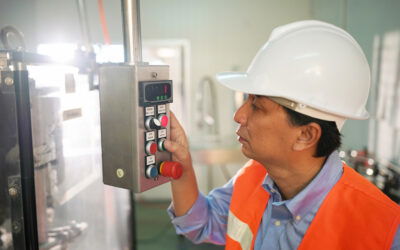In most plants, calculating the overall efficiency of equipment remains an end-of-day exercise. Teams compile data, fill in Excel spreadsheets, and discover problems… when it’s too late to act. This gap between measurement and action transforms OEE into a simple reporting tool. Yet the real value of real-time OEE lies not in its ability to observe what has happened, but in its power to transform what is happening now.
Real-time OEE monitoring radically changes the situation. It gives operators back the power to act, speeds up decision-making, and transforms industrial performance from static reporting to a living management tool.
The trap of deferred reporting: when losses become invisible
An indicator that looks in the rear-view mirror
Traditionally, OEE is calculated at the end of a shift. A production manager retrieves the data, compiles the handwritten downtimes, calculates the availability, performance and quality rates, and then generates a report. The problem? The teams discover that they have lost 8 points in efficiency… even though the day is over.
This approach has several major limitations. It relies on manual data entry, which is prone to omissions and approximation. A 5-minute stop not noted here, a micro-cut forgotten there, and the table becomes inaccurate. It also creates a distance between the problem and its resolution. When an operator discovers the next day that a machine has underperformed, the reasons are blurred, the contexts forgotten, and the opportunities for improvement gone.
The impact of time lag on availability
This delay in information has a tangible impact on production time. Repeated stoppages go unnoticed until they become critical. A machine that suffers ten 3-minute micro-stops in a day loses 30 minutes, but these losses in availability remain invisible without instant follow-up.
The maintenance team discovers recurring breakdowns several days late. Team leaders are unable to adjust priorities during the day due to lack of reliable information. Availability scores plummet, with no way of identifying priority areas for intervention. As a result, OEE becomes an indicator for meetings, not a daily work tool that impacts the business.
Real time: efficiency and responsiveness in the field
See, understand, correct: the new reactivity cycle
Real-time OEE turns this logic on its head. Each connected machine instantly transmits its operating data. As soon as a stoppage occurs, it appears on the workshop screens. The operator sees the duration displayed, identifies the cause via a simple interface, and the information is passed on to the whole team.
This immediate visibility changes everything. A machine stoppage repeated three times in an hour no longer has to wait until the end of the day. The maintenance technician is alerted and can intervene before the problem gets out of hand. A detected quality defect triggers immediate corrective action, avoiding the production of a large number of non-conforming products and limiting quality losses on production lines.
Giving power back to the field
The real change comes from what technology enables teams to do. With real-time OEE tracking, operators regain control over their performance score. They no longer suffer the figures presented the next day, they see them being built up minute by minute.
A team leader can prioritize his interventions according to actual data. If a machine shows a quality rate of 75% at 10 a.m., he can investigate immediately, identify whether it’s a setting or
Real-time cause analysis
Real time creates a new level of transparency between departments. Maintenance immediately sees which machines need attention. Management has a consolidated view of total production, without having to wait for reports. Quality teams can correlate quality problems with current production conditions.
This fluid flow of information eliminates silos and speeds up decision-making. No more meetings to take stock: everyone sees the same reality at the same time, and can work together to solve emerging problems in the production process.
Concrete benefits: improved quality and productivity
Immediate performance gains
Companies that switch to real-time quickly see tangible improvements. The first gains appear within the first few weeks. Simple data visibility changes behavior. Teams become aware of real losses, identify avoidable stoppages, and take swift corrective action to improve production capacity.
Here’s a practical example: a plant stagnating at 65% can gain 3 to 5 points in a few weeks by making microstops visible. These gains don’t require heavy investment, just better use of existing resources thanks to quality information. Cost reduction becomes measurable, and team satisfaction increases. Overallefficiency naturally improves, with a direct impact on return on investment.
Team commitment: a domino effect
Beyond the figures, real time transforms operator involvement. When employees see the direct impact of their actions on their line, they become players in the improvement process. Operators challenge standards, suggest optimizations and take ownership of their indicators. Every component of the manufacturing process is scrutinized and optimized.
This dynamic creates a virtuous circle. Motivated teams detect anomalies more quickly, and share best practices. Performance improves, boosting motivation. Real time creates collective intelligence, improving product quality and boosting productivity.
Efficient predictive maintenance
With a detailed history, maintenance moves from reactive to predictive mode. Downtime patterns reveal the early signs of breakdowns. A machine whose cycle time is progressively increasing signals an upcoming problem, reducing unplanned downtime.
This anticipation avoids costly breakdowns that disrupt production. Teams can plan their interventions at times that have the least impact. Real time transforms OEE from a simple indicator into a maintenance management tool, reporting on uptime and overall equipment effectiveness.
TEEPTRAK: solutions to maximize availability and efficiency
No need to be an IT expert
The main barrier to the deployment of real-time OEE solutions has long been their technical complexity. TEEPTRAK has been designed to eliminate these barriers. The solution captures data directly from running machines, without intrusion into existing PLCs.
Installation is quick, settings intuitive, and the interface accessible to all. TEEPTRAK places simple programs at the service of performance, allowing everyone to concentrate on improvingefficiency rather than on technique.
From shop floor to management: shared information
TeepTrak makes data accessible at all levels. The operator has a screen displaying his line. Shop foremen can view all their production lines on a dashboard. The maintenance manager has access to detailed historical data. Management consults consolidated KPIs.
This democratization creates a common performance culture. Everyone speaks the same language, works on the same figures, and contributes to the collective improvement of productivity and quality.
Quick results: measurable transformation
An automotive supplier stagnating at 62% deployed TEEPTRAK. The first few weeks revealed that 40% of losses were due to unidentified micro-stoppages. Teams were able to reorganize supplies, train operators, and automatically alert maintenance.
Result: +7 points in 6 weeks, without machine investment. The return on investment was seen within the first month, demonstrating the effectiveness of a well-implemented real-time approach to industrial business.
Real-time OEE transforms an observation indicator into an actionable management tool. The benefits are twofold: measurable performance improvement and greater team commitment. With TEEPTRAK, this transformation is accessible to all, with no technical complexity and rapid results. Data is useless if it arrives too late: real time finally makes OEE actionable.




0 Comments